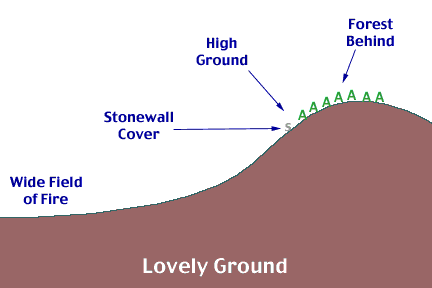|
|
|
|
This series of pictures was taken in front of a New York monument, about where the crest of Cemetery Ridge starts being covered in trees. The pictures taken of "The Hole" are taken from positions marked with Sixth Corps memorials. On the third day, Meade got his way. The Union Sixth Corp's First Division defended the short line along Cemetery ridge. However, The Hole was not an active part of the line on Day Three. No significant action took place in The Hole.
This picture shows the much vaunted "Cemetery Ridge" to be no more than a gentle rise. Beyond the large domed Pennsylvania monument is The Angle. To the right of the tree in the center of the picture, one can see a corner of the Cyclorama building on the peak of Cemetery Hill. While Cemetery Hill shows a steep slope to the town, Cemetery Ridge is high enough to block line of vision from Seminary Ridge, but is not a formidable obstacle. This is typical of the field. There are many mild rises all over the field. Seminary and Cemetery Ridges became famous as the primary lines of Meade and Lee. However, these are not much more formidable than the positions selected by Sickles.
 |
The above is an exaggerated illustration of what I'll call "lovely ground." The Gettysburg battlefield in 1863 was farmland. Flat low land was for the most part cleared. High rocky ground, poor farmland, was often still forested. To ease plowing, rocks were moved from farm fields to stone walls on the edges of the forests. If the hill was at all decent as farm land, the tree line and the stone wall would be located high up the hill.
For a soldier, the result is "lovely ground" to defend. Just hide behind the stone wall, and shoot the enemy as he crosses the open farmland. Cemetery Ridge near Cemetery Hill is the first piece of lovely ground on the photo tour, and not the best example. Cemetery Ridge is not that high, the wall is not that formidable, the woods behind is patchy, but the field of fire in front is wide. Watch for more examples of "lovely ground" as the tour continues. How often, when you see pictures of Union defensive positions, do you see some or all of the following ingredients: high ground, a stone wall, a clear field of fire, and trees in the rear to cover a retreat?
|
|
Panning to the left, Pickett's Charge would have crossed the distant fields, but hit the Union line well to the right, behind the Penn monument.
|
|
Panning further left.
|
|
This is the first shot that shows clearly a valley of grass that distinguishes Sickles' Hole. There is a small woods between the Peach Orchard and Meade's preferred line. However, immediately in front of Meade's line is a hundred yards of grass. The Sixth Corp. lined up in the trees behind the grass, and used the strip of grass as a kill zone. Sickles felt the woods opposite to be higher terrain, and was not content with this position.
This particular stretch of forest didn't exist in 1863. As we get to Hole Center and Hole Right, the tree lines are fairly close to what they were at the time of the battle. Here, however, the woods has been allowed to grow. While there were scattered trees here, it wasn't really a woods.
|
|
The strip of grass continues to the left.
Next: The Hole, Center